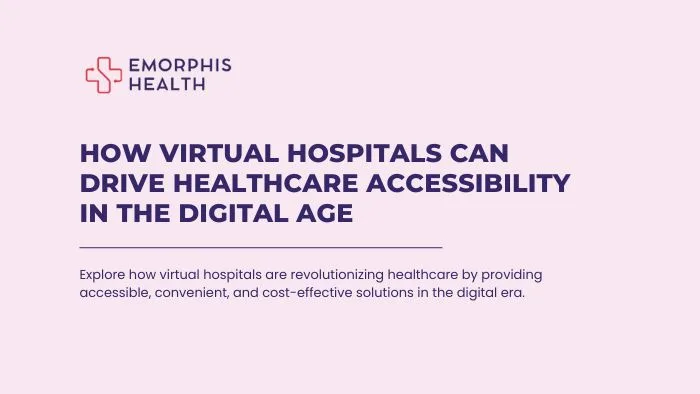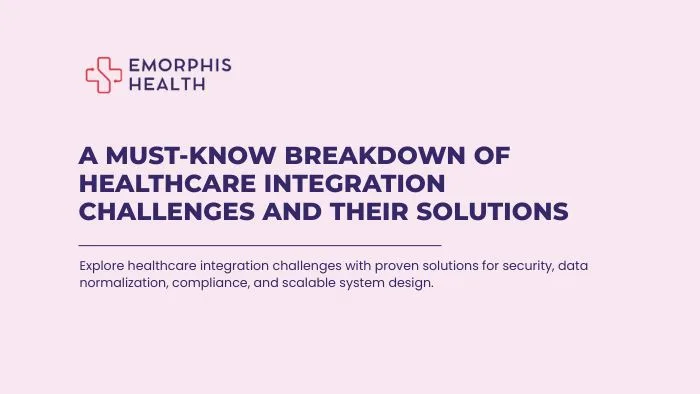What are Virtual Hospitals?
See Contents
- 1 What are Virtual Hospitals?
- 2 Healthcare Accessibility: A Persistent Challenge
- 3 The Rise of Virtual Hospitals: A Digital Solution
- 4 Major Features of Virtual Hospitals
- 5 Why Invest in Virtual Hospitals Software?
- 6 Top 10 Benefits of Virtual Hospitals
- 7 Cost of Virtual Hospital Implementation
- 8 Conclusion
Virtual hospitals are healthcare platforms that deliver medical services to patients remotely. Instead of physically visiting a hospital, patients can consult with doctors, receive treatments, and even monitor their health from the comfort of their homes. These digital healthcare systems utilize technology to provide a wide range of services, including telemedicine, remote patient monitoring, and digital health records, making healthcare more accessible and convenient.
Healthcare Accessibility: A Persistent Challenge
Healthcare accessibility has always been a significant challenge worldwide. Many people face difficulties in accessing quality care due to long distances, lack of transportation, and the high cost of medical services. Rural areas, in particular, struggle with limited healthcare facilities. Moreover, busy schedules and long waiting times often prevent patients from seeking necessary treatments. This leaves a significant gap in how healthcare is delivered, which is where virtual hospitals come into play.
On September 18, 2023, the World Health Organization (WHO) and the World Bank released a joint report highlighting the alarming stagnation in progress towards Universal Health Coverage (UHC). The report reveals that over half of the world’s population still lacks access to essential health services, and billions face severe financial hardship due to out-of-pocket health expenses.
The report underscores the urgent need for increased investments in health systems and stronger political will to achieve UHC. It emphasizes the importance of prioritizing primary healthcare, advancing equity in healthcare access, and strengthening health information systems.
By addressing these challenges, we can ensure that everyone, regardless of their socioeconomic status, has access to quality, affordable, and accessible healthcare. This is crucial for realizing the fundamental human right to health and building healthier, more equitable, and sustainable societies.
Here is the video shared by them in the report.
According to Statista report, a 2024 global survey found that approximately 50% of people worldwide believe the quality of healthcare in their country is good. While countries like Malaysia, Switzerland, and the Netherlands topped the list for high-quality healthcare, Hungary, Poland, and Peru were perceived to have the lowest quality. The data highlights the significant disparities in healthcare quality across different nations.
Moreover, what motivated us to write a blog on the topic was a article published in National Library of Medicine, National healthcare systems worldwide are under immense strain due to various factors. Virtual hospitals (VHs) emerge as a potential solution to alleviate these pressures. By offering remote consultations and digital health tools, VHs can help reduce costs, decrease the workload on healthcare providers, and enable personalized care. This approach also empowers patients to actively manage their health beyond traditional healthcare settings, reducing the need for in-person visits.
Also, a Deloitte’s survey reveals that a significant portion of large health systems, around 60%, are planning to invest more in virtual care. This trend is driven by the increasing popularity of virtual hospitals, which empower patients to take an active role in managing their health. By offering remote consultations and digital health tools, virtual hospitals can improve efficiency for medical staff, reduce costs associated with protective equipment, and ultimately lead to better patient outcomes.
Now let’s check in details on Virtual Hospitals.
The Rise of Virtual Hospitals: A Digital Solution
The rise of virtual hospitals is a result of the growing need for accessible healthcare solutions. With the advent of digital technologies and telemedicine, virtual hospitals have become a viable alternative to traditional healthcare settings. In fact, they provide a simple, efficient way for patients to get the care they need without the constraints of physical location or time. These digital solutions enable healthcare providers to offer continuous care through video consultations, remote monitoring, and instant communication.


According to the MMR report, the virtual hospital market is booming. In 2023, it was valued at $11.05 billion, and it’s projected to grow rapidly at a rate of 31.5% annually. By 2030, the market is expected to reach a substantial $75.40 billion. This rapid growth indicates a significant shift towards virtual healthcare solutions.
In 2023, North America led the way in the virtual hospital market, thanks to its advanced healthcare infrastructure, strong adoption of telehealth, and supportive regulations. The U.S., in particular, has made significant investments in telehealth, with major companies like Teladoc Health and Amwell driving the market.


Asia-Pacific is emerging as the fastest-growing region, with countries like India, China, and Japan rapidly adopting telehealth technologies to improve healthcare access, especially in rural areas. Initiatives like India’s National Digital Health Mission are accelerating the growth of virtual hospitals in the region.
According to Prophecy Market Insights report, the virtual hospital market is set to experience significant growth. In 2024, the market was valued at $13.3 million. However, it’s projected to skyrocket to $116.4 million by 2034, growing at a substantial annual rate of 26.9%. This rapid expansion highlights the increasing demand and potential of virtual healthcare solutions.


Now let’s check in detail about the Virtual hospitals.


Major Features of Virtual Hospitals
- Telemedicine Integration: Virtual hospitals enable remote consultations through video calls, chat, or voice, allowing patients to consult doctors without needing to visit a physical location.
- Remote Patient Monitoring: Virtual hospitals monitor patients’ health conditions in real time using wearable devices and health apps. This is especially beneficial for chronic disease management and post-operative care.
- Electronic Health Records (EHR): Virtual hospitals store patient data digitally, making it easier for healthcare providers to access and share medical histories, diagnoses, and treatment plans with other healthcare professionals. Appointment Scheduling and Management: Patients can book, cancel, or reschedule appointments online, reducing waiting times and improving overall hospital management.
- Prescription Management: Doctors can prescribe medication digitally, which is then sent directly to pharmacies for fulfillment. This streamlines the medication process and eliminates in-person visits.
- Real-Time Communication: Virtual hospitals provide seamless communication between patients, doctors, and other healthcare professionals through messaging, video calls, and notifications for real-time updates.
- Health Education and Resources: Patients have access to digital health education materials, which can help them better understand their conditions and treatment plans.


Now, let’s check how it is helpful, but first, let us check why this needs to be funded at this hour.
Why Invest in Virtual Hospitals Software?
Investing in virtual hospital software is a smart decision for healthcare providers looking to modernize their services. As healthcare continues to shift towards digital solutions, virtual hospital software provides a cost-effective way to offer high-quality care to a wider range of patients. Moreover, it enables healthcare systems to be more adaptable, flexible, and responsive to patient needs. In fact, virtual hospitals play a crucial role in improving healthcare delivery and meeting the growing demand for accessible services. Virtual hospitals are revolutionizing healthcare by offering accessible, affordable, and efficient care. Understanding their benefits is crucial for improving healthcare delivery and patient outcomes.
A McKinsey’s study found that a single virtual hospital in a major Australian city could treat nearly 10,000 patients virtually each year. This would free up 130 hospital beds, equivalent to 47,500 bed days annually.
Also, they have mentioned the other benefits that are improved patient satisfaction, and cost savings.
Top 10 Benefits of Virtual Hospitals
1. Increased Accessibility
One of the most significant advantages of virtual hospitals is their ability to provide healthcare services to a broader population, especially those in remote or underserved areas. Patients who live far from traditional healthcare facilities no longer have to travel long distances to see a doctor. With virtual consultations, anyone with internet access can speak to a healthcare provider without leaving their home. This is particularly beneficial for people who have mobility issues, live in rural areas, or do not have easy access to transportation.
2. Cost Efficiency
Virtual hospitals help reduce the overall cost of healthcare by eliminating the need for physical infrastructure, such as large hospital buildings, expensive equipment, and administrative staff. Patients also save money by avoiding travel costs, parking fees, and other expenses associated with in-person visits. Moreover, healthcare providers can allocate resources more efficiently, focusing on providing care rather than managing in-person logistics. This cost savings benefits both patients and healthcare systems, making it easier for more people to afford quality healthcare.
3. Time Savings
Virtual hospitals save both patients and healthcare providers valuable time. Patients no longer need to wait for weeks or hours to get an appointment or travel long distances to receive care. Virtual consultations can be scheduled and conducted at the patient’s convenience, reducing waiting times and allowing for more timely treatment. For healthcare providers, virtual consultations streamline the process by allowing them to see more patients in less time, increasing overall productivity and efficiency.
4. Improved Patient Engagement
Virtual hospitals enhance patient engagement by offering continuous access to healthcare services. Patients can stay connected with their healthcare providers between visits through telemedicine platforms, enabling timely follow-ups and regular monitoring of their health conditions. This increased communication helps patients stay informed about their treatment plans, leading to better adherence to medication and lifestyle changes. As a result, patients are more involved in their healthcare decisions, which can lead to improved outcomes.
5. Better Management of Chronic Conditions
Virtual hospitals are particularly beneficial for patients with chronic conditions that require ongoing management, such as diabetes, hypertension, or asthma. Remote monitoring tools allow healthcare providers to track patients’ vital signs in real-time, ensuring that they receive the care they need before their condition worsens. By offering consistent monitoring and support, virtual hospitals enable early intervention, reducing the risk of complications and hospital readmissions. This proactive approach leads to better health outcomes for patients with long-term health issues.
6. Convenience for Patients
The convenience factor cannot be overstated when it comes to virtual hospitals. Patients no longer need to take time off work or arrange childcare to attend a doctor’s appointment. Virtual consultations can take place at any time of day, from the comfort of a patient’s home or any location that is convenient for them. Additionally, patients can access a wide range of healthcare services, including mental health support, follow-up care, and preventive care, all through their smartphones or computers.
7. Reduced Hospital Overcrowding
Virtual hospitals help reduce overcrowding in physical hospitals by diverting non-emergency cases to virtual consultations. This frees up valuable hospital resources for patients who require urgent or in-person care, improving the overall efficiency of healthcare facilities. By addressing minor issues and routine check-ups through virtual consultations, hospitals can better manage patient flow and focus on critical cases.
8. Better Continuity of Care
Continuity of care is another benefit that virtual hospitals provide. Patients can maintain ongoing relationships with healthcare providers, even when they move to a new city or travel abroad. Virtual hospitals allow for seamless transitions between different healthcare providers, ensuring that patients’ medical records are always accessible, and their treatment plans remain consistent. This continuity is essential for managing long-term or complex conditions that require ongoing monitoring.
9. Health Education and Awareness
Virtual hospitals also serve as platforms for health education. Many virtual hospital systems offer educational resources, such as webinars, instructional videos, and articles, to help patients better understand their health conditions and treatment options. These resources empower patients to take charge of their health by providing them with the information they need to make informed decisions. Moreover, health education materials can be personalized based on a patient’s medical history or specific needs.
10. Scalability of Services
As healthcare demand increases, virtual hospitals provide the scalability that traditional systems struggle to achieve. They allow healthcare providers to expand their services without the constraints of physical space or location. For example, a healthcare network can offer virtual consultations to patients in multiple regions or even countries without needing to build new hospitals or hire additional staff. This scalability is particularly valuable in times of crises, such as during a pandemic, where the demand for healthcare services can suddenly increase.
Cost of Virtual Hospital Implementation
The cost of implementing virtual hospitals can vary depending on the scale of the project and the features required. Generally, the cost involves investments in technology, such as telemedicine platforms, remote monitoring devices, and secure data storage solutions. Hospitals may also need to train staff to effectively use virtual hospital systems and integrate them with existing healthcare workflows. However, the long-term savings in operational costs and the ability to serve more patients make virtual hospitals a worthwhile investment. In fact, many hospitals find that the initial investment is quickly offset by the increased efficiency and the ability to deliver care remotely.
Summary of Costs
- Initial Setup: $50,000 to $500,000 (Technology, infrastructure, software)
- Annual Operating Costs: $100,000 to $500,000 (Staffing, marketing, compliance, maintenance)
While initial costs can be substantial, the long-term benefits of virtual hospitals, such as increased accessibility and reduced overhead, make them a valuable investment.
Conclusion
In conclusion, virtual hospitals are revolutionizing healthcare by offering accessible, cost-effective, and efficient solutions to patients and providers alike. As digital healthcare continues to grow, virtual hospitals will play an even more vital role in shaping the future of healthcare delivery.
Connect with us, for more details.










